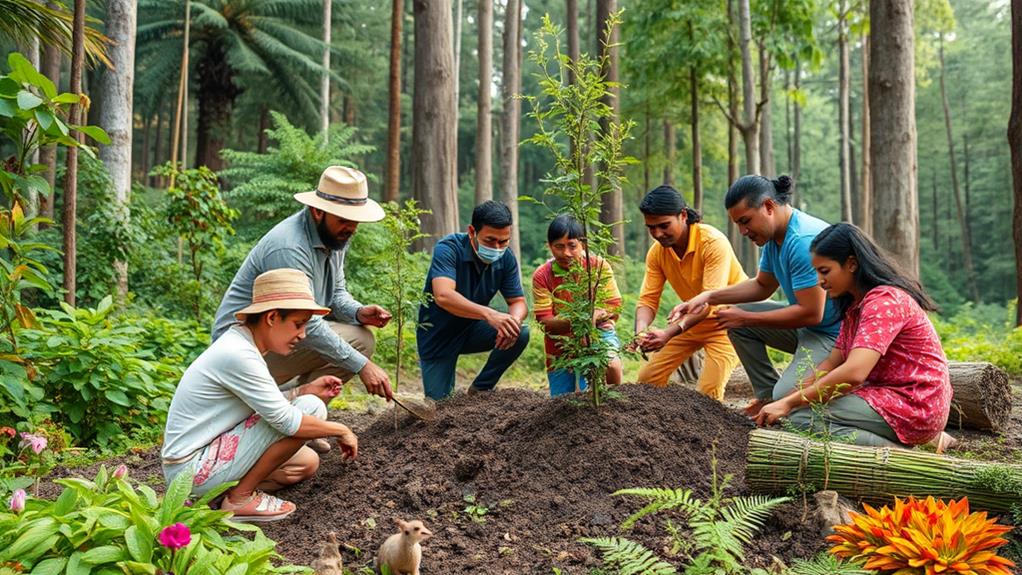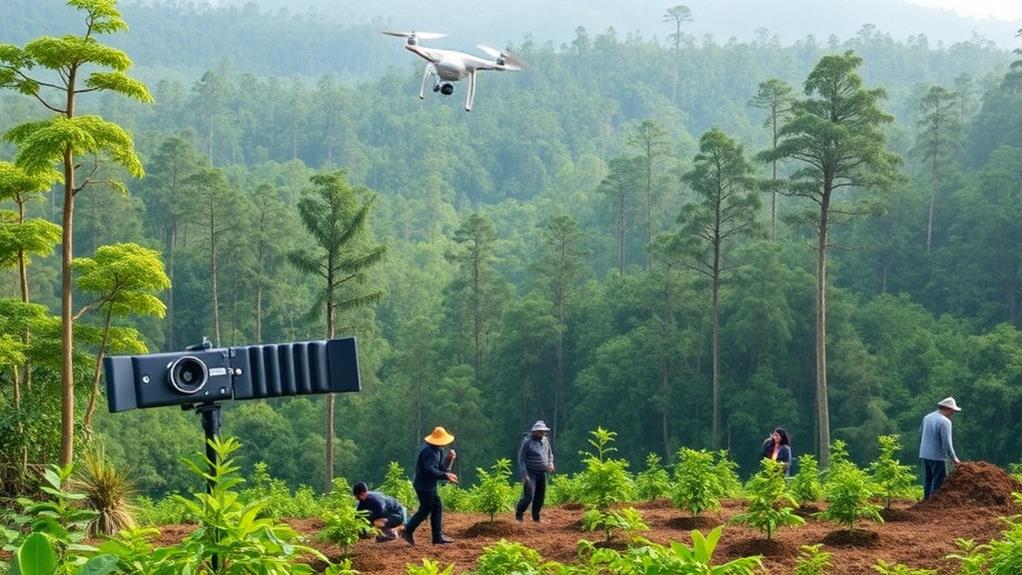The future of the forestry industry in the Philippines depends on tackling climate challenges and using sustainable resources. Healthy forests are important because they can increase water supply and lower flood risks, which helps local communities. For example, when forests are well-maintained, they hold more water and prevent heavy rains from causing floods.
The government has programs like the National Greening Program, which works to reverse deforestation and get communities involved. This program helps plant trees in areas that have lost forest cover.
There is also a growing demand for eco-friendly products in the market. This trend indicates that there could be high export and import values for these products. For instance, items made from sustainably sourced wood are becoming popular both locally and internationally.
As more people and businesses focus on sustainability, there is a chance for economic growth through reforestation and new practices. Reforestation involves planting trees in areas where forests have been cut down, and this can create jobs and improve the economy.
Overall, these trends will likely shape the forestry industry in the Philippines in the coming years. Furthermore, the shift towards sustainable forestry practices and the implementation of stricter regulations will be necessary to address deforestation and promote reforestation efforts. In addition, the integration of sustainable fishing practices will play a crucial role in preserving the country’s marine biodiversity and supporting the livelihoods of coastal communities. These developments will not only benefit the environment, but also contribute to the long-term sustainability of the forestry industry in the Philippines.
Importance of Forest Ecosystem Services

Forests in the Philippines provide important ecosystem services that are essential for community well-being. These forests supply resources like timber and clean water, which directly support local livelihoods. Many communities earn about 7% of their annual income from selling forest resources. This shows that healthy forests are vital, especially as the Philippines is one of the countries most affected by climate change.
The services offered by forests go beyond just making money; they help protect communities from climate shocks. As extreme weather and changing seasons become more common, the role of these forests becomes even more crucial.
If forests aren't managed and protected, communities could lose these vital services, which would make it harder to fight poverty. Therefore, it's important to recognize and value forest ecosystem services for long-term community stability.
Climate Change Impacts on Forestry
The forestry sector in the Philippines is facing serious challenges due to climate change. The country is one of the top five nations most affected by climate change, which leads to more extreme weather events like storms and floods. These events harm forest ecosystems, making it difficult for trees and wildlife to thrive.
Climate-related disasters cost the Philippines over $8.45 billion each year. This financial loss severely affects the health of forests and their management. Forests provide important services, such as protecting communities from climate shocks and helping to reduce poverty. However, climate change threatens these services, which could make it harder for people to escape poverty.
To address these issues, adaptive strategies in forest management are essential. For example, planting more resilient tree species can help forests withstand harsh weather.
Developing strong forest ecosystems not only helps protect wildlife but also supports local communities in dealing with climate change. The future of forestry in the Philippines depends on taking proactive steps to combat the impacts of climate change.
Economic Valuation of Forest Resources

Understanding the economic valuation of forest resources in the Philippines is crucial for tackling climate change. Healthy forests can increase water supply by 149-167% and reduce floodwater by 27-47% during rainy seasons. This shows their important role in climate protection and the need for proper valuation methods.
The forestry sector helps the national GDP, with steady growth in Gross Value Added (GVA) from 2016 to 2019, even with challenges from the COVID-19 pandemic. Using sustainable forest management practices can further increase long-term GVA, create jobs, and support local communities, where forest resource sales contribute about 7% of their annual income.
To fully utilize these benefits, there's an urgent need for a national database on forest ecosystem services. This database would help in planning and investment, ensuring that the economic value of forest resources is recognized.
This would enable local communities to thrive while also promoting environmental sustainability.
Government Strategies and Initiatives
The Philippine government is taking strong actions to fight deforestation and support sustainable forestry. One major program is the National Greening Program. This program aims to improve the environment by focusing on the importance of healthy forests for the economy and nature. It works to reverse deforestation trends by including ecosystem services in planning.
Another important initiative is the Forest Investment Road Map (FIRM). This program encourages private sector involvement by showing how sustainable forestry can be profitable. The goal is to create a partnership between businesses and the government, so both can benefit while taking care of the forests and local communities.
The government also emphasizes tree planting that provides measurable benefits to the ecosystem. This ensures that reforestation efforts help the environment and meet the needs of local people.
Additionally, a national database on forest ecosystem services is being developed. This resource will help improve decisions about forest management.
Collaboration among government agencies, local communities, and private stakeholders is key for successful forest management. These strategies aim not only to stop deforestation but also to create a sustainable future for the forestry industry in the Philippines.
Community Engagement and Collaboration

The success of government strategies in the Philippine forestry sector depends on community engagement and collaboration. Local communities understand the benefits forests provide, but they face challenges like difficulties with charcoal-making and water supply. To solve these issues, it is important to engage with communities. For example, knowing how people rely on forests helps explain the problems of siltation in damaged areas, which harms their water sources.
Working together with local governments on data collection and policy creation can help reduce the effects of forest damage on communities. When communities are empowered, they can take part in decisions that affect their jobs and the health of forests. Programs like the National Greening Program show that including community voices is key to stopping deforestation.
| Key Aspects | Importance | Local Government Role |
|---|---|---|
| Community Engagement | Increases local awareness | Helps with communication |
| Data Collection | Guides policies | Supports research efforts |
| Empowerment | Involves local stakeholders | Offers resources and training |
| Sustainable Practices | Encourages long-term plans | Works as a partner in actions |
Reforestation and Carbon Credit Programs
In September 2023, Marubeni started a reforestation project in Negros Occidental. This project focuses on planting native Philippine tree species to create carbon credits. It's the first time industry, universities, and the government are working together, involving the Department of Environment and Natural Resources (DENR) and the University of the Philippines Los Baños. This initiative responds to the serious issue of forest cover dropping from 70% to 20% because of poor logging practices.
This project has several important goals:
- Biodiversity Restoration: The reforestation will help bring back lost ecosystems by planting native species, which will support local wildlife and plants.
- Carbon Credit Trading: The program will generate carbon credits through the J-Credit Scheme. This means businesses can buy these credits to support forest protection and benefit financially.
- Community Engagement: The project includes educational programs to change how locals view forests. It will show them how protecting forests can provide economic benefits.
- Sustainable Development: Money earned from carbon credits will be used to improve community projects, which will help local people while also caring for the environment.
This approach not only fights against environmental harm but also helps communities grow economically with sustainable methods.
Future Market Trends and Opportunities

Reforestation projects like Marubeni's in Negros Occidental are making the Philippine forestry market grow. The import value of forest resources is expected to reach US$2.8 billion in 2024, with a growth rate of 4.76% from 2024 to 2029. This shows a strong demand for materials that are sourced sustainably.
The export value for forest products is projected to be US$0.5 billion in 2024, growing at a rate of 6.84%. Countries like Spain, Italy, and Germany are important trading partners, showing a wide interest in these resources.
The future of the market includes several opportunities in different product categories:
| Product Category | Projected Growth Opportunity |
|---|---|
| Raw Materials | High |
| Primary Processed Timber | Moderate |
| Engineered Wood Products | High |
| Pulp & Recovered Materials | Moderate |
| Paper & Paperboard Products | High |
As more people want eco-friendly products, companies can benefit by following certifications like FSC or PEFC. Adapting to these trends is important for everyone in the forestry industry.
Questions and Answers
What Is the Current Status of Forest Resources in the Philippines?
The status of forest resources in the Philippines is declining. Deforestation is a major issue that affects ecosystems and the well-being of communities. For example, when trees are cut down, animals lose their homes, which can lead to extinction. Additionally, forests help to prevent soil erosion. If there are fewer trees, economic stability is also at risk because many people depend on forests for their livelihoods. To fix these problems, sustainable management practices and biodiversity conservation efforts are essential. Immediate action is needed to protect these valuable resources.
What Is the Future of the Forestry Industry?
The future of the forestry industry depends on sustainable practices and technological advancements. Sustainable practices include methods like selective logging, which allows trees to grow back while still harvesting wood. This helps maintain ecosystems. Technological advancements, such as drones and satellite imaging, improve resource management by providing detailed maps of forests. These tools help monitor tree health and identify areas needing protection.
By focusing on these areas, the forestry industry can increase productivity. For example, using technology to track tree growth can lead to better planning for harvesting. This not only increases efficiency but also ensures that forests remain healthy.
What Are the Problems With the Wood Industry in the Philippines?
The wood industry in the Philippines faces significant challenges. Illegal logging is a major issue, as it leads to deforestation and loss of biodiversity. For example, many trees are cut down without permission, harming the environment. Additionally, there is a lack of interest in sustainable practices among forest owners. Many do not recognize how sustainable logging could benefit both the environment and their own income. This neglect can result in further environmental degradation and limit economic opportunities for local communities. Overall, these problems hinder both environmental preservation and economic growth in the region.
What Are the Problems With Forests in the Philippines?
Deforestation in the Philippines harms biodiversity and local communities. When forests are cut down, many plant and animal species lose their homes, leading to a decrease in biodiversity. For example, the Philippine eagle, one of the world's rarest birds, is at risk because of habitat loss. Illegal logging makes these problems worse. This practice not only reduces the number of trees but also encourages more forest destruction. The loss of forest cover threatens ecosystems. This can lead to problems like soil erosion and increased flooding during heavy rains. Immediate action is needed for sustainable forest management. Protecting forests is crucial for preserving wildlife and supporting the livelihoods of people who depend on these resources.